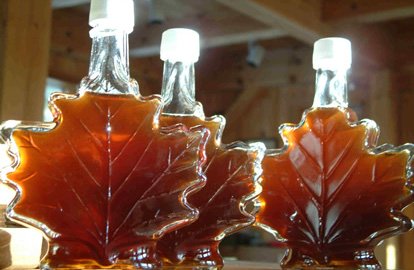Why to Use Real Maple Syrup as a Healthful Natural Sweetener

 Real maple syrup is not the stuff that comes in little packets at cheap eateries. Nor is it the watery stuff served at International House of Pancakes. And it isn’t your average not-at-all nutritional Log Cabin or Aunt Jemima colored sugar water. Actually, real maple syrup can be quite beneficial and useful as a natural sweetener.
Real maple syrup is not the stuff that comes in little packets at cheap eateries. Nor is it the watery stuff served at International House of Pancakes. And it isn’t your average not-at-all nutritional Log Cabin or Aunt Jemima colored sugar water. Actually, real maple syrup can be quite beneficial and useful as a natural sweetener.
Maple syrup starts as a sap from maple trees in the Quebec Province of Canada or in the upper New York or New England states. Sugar maples grow elsewhere, but those trees are often used for lumber. The maple syrup industry’s main sources are in those northern states mentioned.
If the sap is collected early in the spring season, it requires over 20 gallons of water to be boiled out for one gallon of light amber colored syrup, labeled as Grade A. This grade has more to do with the timing than the quality, as many prefer Grade B maple syrup, which is tapped at the end of the spring harvesting season.
Because sap toward the end of the season is more watery, it requires boiling out much more water to get a gallon than the 20+ needed for Grade A syrup. More boiling increases thickness, deepens color, adds flavor, and boosts nutritional concentration. Some time ago, because of conditioned quality assumptions based on alphabet sequencing, Grade A was the preferred syrup.
That changed as more factual information about Grade B syrup came out.
Nutritional Value
The big news lately was released at the 241st American Chemical Society’s (ACS) National Meeting in Ahaheim, California in March 2014. University of Rhode Island assistant pharmacy professor and researcher Navindra Seeram revealed 34 new beneficial compounds, bringing the total to 54 in pure Quebec maple syrup.
Twenty were discovered during the year prior to this ACS conference, five of which had never been seen in nature. High mineral content in maple syrup has been known for years. Manganese, magnesium, calcium, and zinc make maple syrup similar to molasses with mineral content without the overpowering taste of molasses.
Most of our food comes from soil that has been minerally depleted, yielding foods with less minerals. Most of our bad health comes from mineral deficiencies. Minerals are keys for metabolizing vitamins.
But wait, there’s more! Those normally obscure polyphenols and antioxidant compounds that demand closer looking are among the 54 healthy compounds found in maple syrup. Some are anti-cancer and a few are helpful for avoiding diabetes to the point where “pre-diabetic” metabolic disorder folks can use pure maple syrup moderately.
More recently, a Japanese study conducted by Dr. Keiko Abe of the University of Tokyo’s Graduate School of Agricultural and Life Sciences, determined that mice fed real maple syrup had much better liver function than mice fed sugar water fake syrups, like the kind served in restaurants and sold throughout supermarkets. So pure maple syrup is a sweetener that enhances liver function.
At the ACS conference, Seeram stated,
“I continue to say that nature is the best chemist, and that maple syrup is becoming a champion food when it comes to the number and variety of beneficial compounds found in it.” He added, “It’s important to note that in our laboratory research we found that several of these compounds possess anti-oxidant and anti-inflammatory properties, which have been shown to fight cancer, diabetes and bacterial illnesses.”
By using pure maple syrup as a sweetener when appropriate, you are helping yourself overcome mineral deficiencies, fight cancer and diabetes, and promote better health. How sweet is that?
